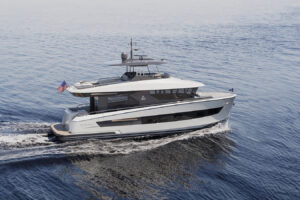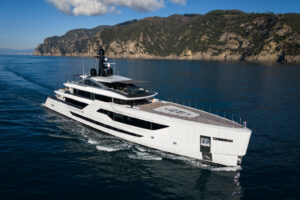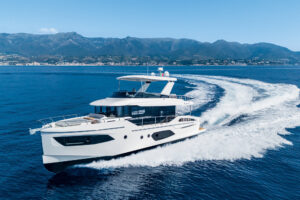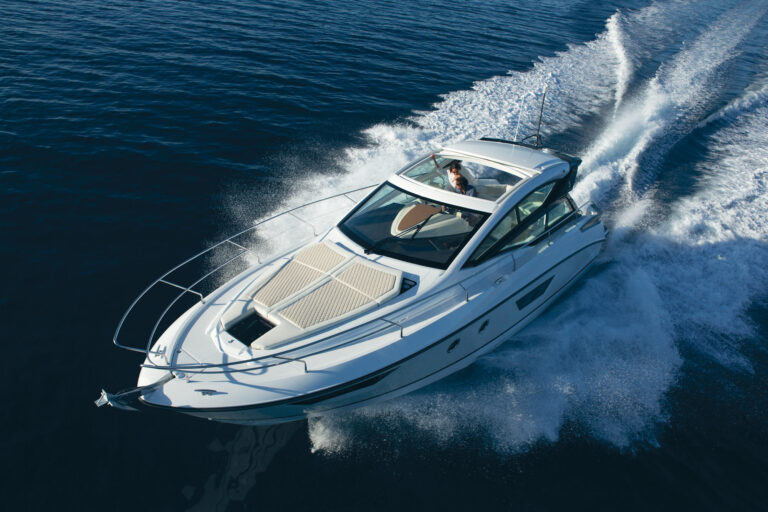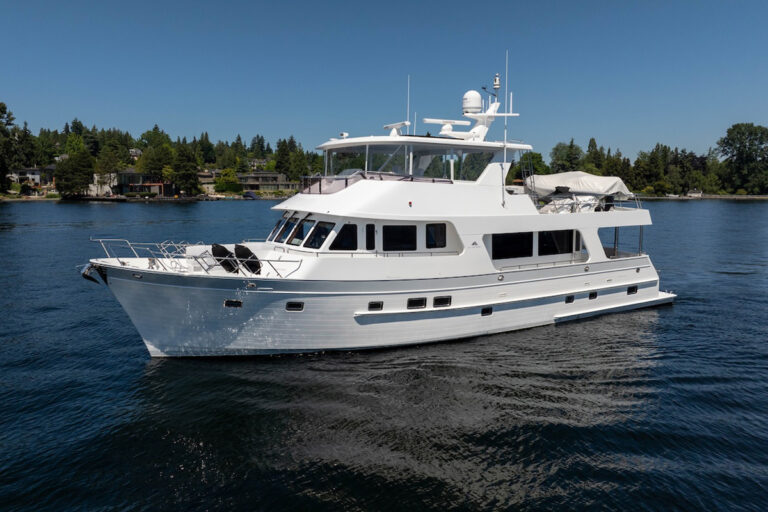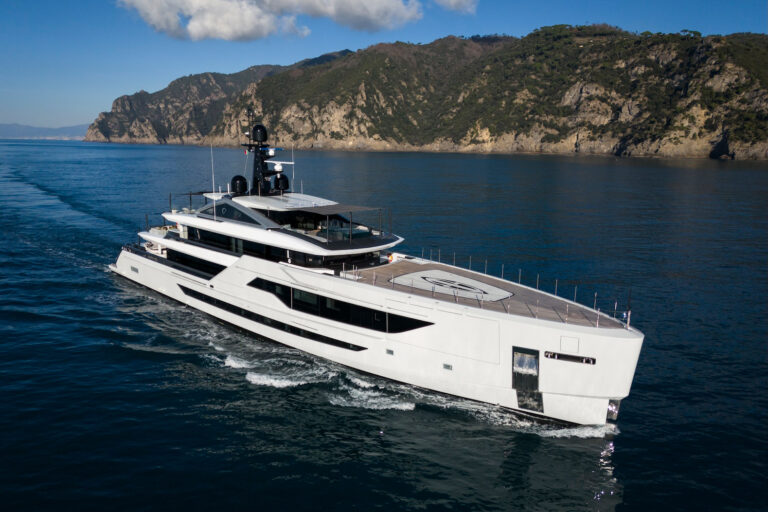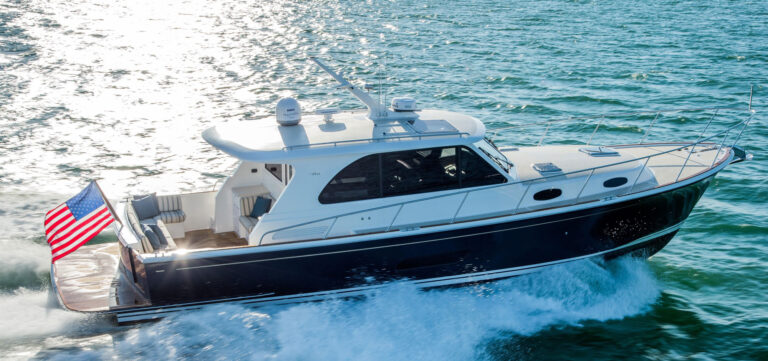Long before we started the big Volvo Pentas, the Carver 570 Voyager impressed me with her thoughtful arrangement plan, standard equipment, materials and workmanship. The company’s goal is to build comfortable, luxurious cruising yachts at a reasonable price, and this boat fits the profile nicely.
The impressions began when I closed the massive door to the saloon on the main deck. Framed in stainless steel, the door slid easily, though not quite silently, and latched with a solid thunk. Golden sunlight from huge windows port and starboard washed the saloon. This would be perfect on a frosty autumn morning, when you could relax in one of the barrel chairs, cappuccino warming your hands.
But we were in West Palm Beach, Florida. At this latitude, most owners will close the mini-blinds, draw the draperies over the door to the cockpit, and turn on the air conditioner. The air-conditioning vents are hidden behind nicely crafted cherry valances around the perimeter of the overhead, so the chilled air cascades into the saloon and creates a natural convection that quickly cools the entire area, not just the sole.
Most production boats, which have to appeal to a broad cross-section of yachtsmen, leave the factory with conservative interior furnishings and accessories. The 570’s light, earth-tone carpeting, off-white overhead, beige UltraLeather settee and earth-tone barrel chairs won’t offend anyone. Nor will the décor excite some folks, but creative dec-orators can enliven the environment with colorful throw pillows, an area rug, silk flower arrangements and hanging artwork.
Curved settees draw lots of “oohs” and “aahs” from shoppers because the shapes add drama to the simple rectangular space. The seating is comfortable, as is the J-shape settee aboard the 570, but some folks might miss having a right-angle corner to read or nap.
Carver expanded the saloon as much as it could without squeezing the side decks into the toerail. I was able to walk the side decks with my shoulders square to the direction of travel, but I’m a small person. The safety rail is angled outboard, bottom to top, so if you plant one foot in front of the other, you can walk the side decks without turning sideways. This compromise in width of the decks goes a long way toward visually, and literally, opening the saloon.
Placing the galley at the forward end of the saloon, in the style of a country kitchen/dining room, also helps to expand the space visually. The inboard end of the counter curves gently toward the centerline, defining the outer edge of the galley space and the inner edge of the companionway forward to the pilothouse. This curve softens the transition and eliminates at least one corner against which you may fetch up if you lose your balance in rough weather.
The best part of the country-kitchen layout is the snack counter. It’s about 8 inches lower than the galley counter and follows the same curvature. A couple of stools provide seating that will remind many guests of childhood days at the local ice cream parlor.
Beneath the main part of the counter on the galley side are the refrigerator and a stowage cabinet. A useful double sink is at the outboard end of the galley, and the stove is along the forward bulkhead.
The 570 is a luxurious cruising boat for the whole family, but her helm is an attractive mix of aircraft cockpit and lounge. Paved in UltraLeather, the helm chair pushes and gives in all the right places. The bow thruster joystick is at the forward end of the chair’s starboard-side arm.
Instrumentation fans out in a semicircle within the line of sight. The plotter, radar and closed-circuit television screens are in a nacelle above the windscreen-a questionable placement captains will need to spend some time with before they know whether they like it. On the other hand, the helm’s centerline placement provides an excellent view, even aft to starboard of the galley, and allows better distance judgments than most offset helms.
Tied up starboard side-to in West Palm Beach, Florida, we cast off the bow and spring lines. Engaging forward on the starboard engine and reverse on the port pressed the stern against the giant fender and strained the stern line, swinging the bow clear of the boat in front of us. We cast off the stern line and idled at 650 to maintain a no-wake speed (5.7 knots) until we cleared the narrow canals and single bascule bridge.
Out in Lake Worth, we ran the 570 north and south at a full range of speeds, but not in a full range of conditions. Light winds and chop prevailed, so we took advantage of every wake we could find. Like the other large Carvers I’ve driven, the 570 accelerated briskly and felt well planted in the turns and over wakes. The steering was smooth and easy, but it didn’t have the rheostat feel of some over-assisted steering systems. I could sense some load on the rudders as I turned.
We reached an upwind top speed of 28 knots at 2325 rpm, quickly enough to satisfy most cruising skippers, and the boat balanced nicely with the tabs all the way up. I suspect she won’t need tabs often if owners are careful about weight distribution. Our maximum speed was 30.9 knots on the GPS at 2400 rpm, downwind.
Back at the dock, I went below to have a look at the master stateroom, which is among the most inviting in the production boat industry. It has cherry joinery varnished to a high gloss, three hanging lockers and a five-drawer dresser. A creative use of space and lighting will make casual observers think the yacht is worth twice her price tag. Closer inspection reveals the compromises that go with a production boat-extra space around doors and drawers, and medium-grade hardware-but these details won’t bother buyers looking for comfortable cruising.
Carver redefined the term “head” in the 570. The design team cleverly created three components opposite the queen-size berth. The middle houses the sink/vanity, the left houses the toilet, and the right has the shower stall. Carver has played the game of value with few serious compromises. Instead of leaving out a feature or cheating on raw materials, the company cuts production costs by streamlining methods.
The result in the case of the 570 Voyager is a cruising yacht sure to push each owner’s pride button. Contact: Carver Yachts, (920) 822-1600; fax (920) 822-8820; www.carveryachts.com.

